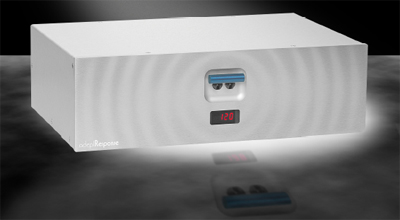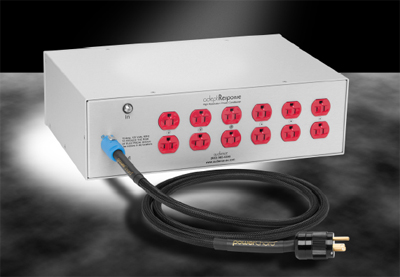You are reading the older HTML site
Positive Feedback
ISSUE
22
audience
adeptResponse line conditioner
as reviewed by Fown-Ming Tien

|
FOWN-MING TIEN'S SYSTEM
LOUDSPEAKERS
ELECTRONICS
SOURCES
CABLES
ACCESSORIES |
Until I experienced the Audience adeptResponse power line conditioner (read Tom Campbell's review here), I had never encountered a piece of audio gear that was perfect in every way. There were always some tradeoffs in sound, aesthetics, or both. This is the most attractive power line conditioner I have ever seen. The satin anodized aluminum casing looks very classy, and the ripple effect on the faceplate is a stroke of artistic genius. The only other items on the faceplate are a digital LED readout indicating the incoming voltage and a high-quality magnetic circuit breaker. Other power conditioners either look like nondescript metal boxes or like Christmas trees, with glowing lights and colored decals.
A peek at the rear of the adeptResponse reveals six high-quality Hubbell duplex outlets and a coax input for Satellite/Cable TV hook up for Ground loop isolation transformer hum reduction. The twelve outlets should be enough to power any system. Not surprisingly, the link from the wall to the adeptResponse is a six-foot length of Audience's own excellent powerChord (see that review here). This is connected via a Neutrik 20A PowerCon connector to the power conditioner and a Marinco plug to the outlet. High-quality Audience Auricaps provide filtering to ensure that the power coming from the wall outlet leaves squeaky-clean.
The use of high-quality parts does not guarantee high-quality sound. In the case of the adeptResponse, it certainly does—in spades. Before evaluating the adeptResponse, I let the review sample burn in for a few months. Compared to my Tice Powerblock, the adeptResponse made a dramatic and profound impact. It simply made everything sound much better. Sometimes a piece of gear can make the system sound different, but different does not always mean better, so exactly what do I mean by better? The highs and mids were smoother and sweeter, and had less harshness and glare, especially on female vocals. The adeptResponse completely eliminated the edginess in Eva Cassidy's voice on Songbird, and it allowed fine nuances and textures to be conveyed clearly. Details that I had never heard suddenly surfaced, on every recording. One-note bass now had definition that had previously been masked. Backgrounds became blacker.
Although the adeptResponse netted substantial sonic gains across the board, the area in which the improvement was greatest was soundstage depth and the placement of instruments. With the Tice Powerblock, everything sounded more forward, two-dimensional, and compresseds. Vocalists and musicians seemed to be a few feet in front of me. The Audience conditioner deepened and widened the soundstage, allowing the musicians to be more realistically placed within the soundstage. Everything sounded more spacious.
While all of these changes were positive, I have found that improvements do not always guarantee a perfect result. Do you continue to focus on specific sonic attributes, or do you forget about being critical and get whisked away on a journey? The adeptResponse excelled in this! With the adeptResponse in the system, music was more enjoyable and engaging. All of the details—gigantic and minute—that elicit an emotional response were made evident. A large part of the enjoyment of music comes from the spiritual connection that occurs during the act of listening. Few other components have allowed me to be drawn into the music as much as the adeptResponse. Fewer yet have the ability to improve the rest of the system. Like the consummate team player who is able to improve the performance of those around him, the adeptResponse extracted better performance out of all gear plugged into it. The degree of improvement ranged from small to large, but every piece of gear plugged into the adeptResponse sounded better in every way. A Pioneer Elite DV-47A and a Modwright Pioneer Elite DV-47Ai were enormously improved, while an Empirical Audio Perpetual Technologies P-3/A, a TEAC Esoteric DV-50, and a McCormack UDP-1 showed smaller, less dramatic improvements. Amplifiers usually sound best when plugged directly into the wall, but amplifiers including the NuForce Reference 8, the Son of Ampzilla, and the Eastern Electric MiniMax M-520 all sounded more refined when plugged into the adeptResponse, and none exhibited any loss of dynamics.
I had a chance to hear the adeptResponse in two other systems. I happened to be in attendance when fellow PFO reviewer Jeff Parks replaced a Sound Applications CF-X line conditioner with the adeptResponse in his system, and I heard the same improvements that I experienced in my system. Strident-sounding tracks were considerably smoothed out. An upper-bass rise that had been overpowering the room was also tamed. In a system that already sounded very good, the adeptResponse helped create a more truthful, balanced presentation.
In Mike Garner's (www.tweekgeek.com) system, I was able to compare the adeptResponse to the excellent BPT BP-2 power conditioner. On that day, Mike's system consisted of a Bryston BP-25DA preamp, NuForce Reference 8 monoblock amps, a McCormack UDP-1, and SP Tech Timepiece 2.1 loudspeakers. The BPT (a transformer-based unit) imparted a hardness, an etched quality, and a sizzle to the music that was similar to what I heard in my system with the Tice PowerBlock, but when the system was plugged into the adeptResponse, the edginess melted away and texture and palpability were heightened, especially in the midrange and bass. The system's mild bass boom was tamed. I preferred the more musical and accurate sound of Mike's neutral and revealing system with the adeptResponse.
In addition to confirming what I had heard in my own system, the listening session at Mike's became truly ear-opening when Gary Brashear placed the adeptResponse on a Stillpoints component stand. Decoupling the power conditioner from the component rack raised the sonic presentation to another level. The separation of instruments, which was already superb, got better, as did focus. Images had more solidity. Background noise was reduced even further. Soundstage depth, which was already quite stellar, also improved. Images that had floated in space were now firmly anchored, but had a more spacious and holographic feel.
At $3800, the Audience adeptResponse is not inexpensive, but given its ability to improve the sound of everything connected to it, I feel that it is worth every penny. Audio gear is always about compromise. The Audience adeptResponse is the first and only component I have experienced that represents zero compromise. Fown Ming-Tien

adeptResponse
Retail: $3800
Audience
web address: www.audience-av.com
